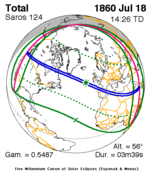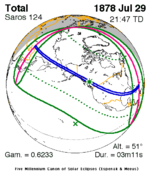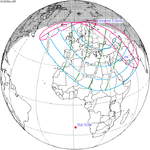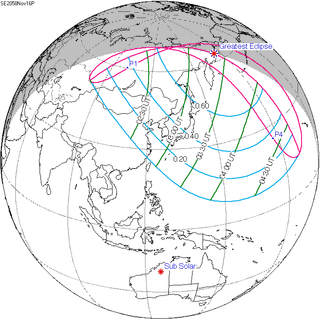A partial solar eclipse will occur on Saturday, November 16, 2058. A solar eclipse occurs when the Moon passes between Earth and the Sun, thereby totally or partly obscuring the image of the Sun for a viewer on Earth. A partial solar eclipse occurs in the polar regions of the Earth when the center of the Moon's shadow misses the Earth.
YouTube Encyclopedic
-
1/1Views:2 133
-
Saturday January 5, 2013: Shemot "Names"
Transcription
Related eclipses
Solar eclipses 2059–2061
This eclipse is a member of a semester series. An eclipse in a semester series of solar eclipses repeats approximately every 177 days and 4 hours (a semester) at alternating nodes of the Moon's orbit.[1]
| Solar eclipses 2059–2061 | |||||
|---|---|---|---|---|---|
| 119 | May 22, 2058 Partial |
124 | November 16, 2058 Partial | ||
| 129 | May 11, 2059 Total |
134 | November 5, 2059 Annular | ||
| 139 | April 30, 2060 Total |
144 | October 24, 2060 Annular | ||
| 149 | April 20, 2061 Total |
154 | October 13, 2061 Annular | ||
Saros 124
Solar saros 124, repeating every about 18 years and 11 days, contains 73 events. The series started with partial solar eclipse on March 6, 1049. It contains total eclipses from June 12, 1211, to September 22, 1968, and a hybrid solar eclipse on October 3, 1986. The series ends at member 73 as a partial eclipse on May 11, 2347. The longest total eclipse occurred on May 3, 1734, at 5 minutes and 46 seconds.[2]
| Series members 43–59 occur between 1801 and 2100: | ||
|---|---|---|
| 43 | 44 | 45 |
 June 16, 1806 |
 June 26, 1824 |
 July 8, 1842 |
| 46 | 47 | 48 |
 July 18, 1860 |
 July 29, 1878 |
 August 9, 1896 |
| 49 | 50 | 51 |
 August 21, 1914 |
 August 31, 1932 |
 September 12, 1950 |
| 52 | 53 | 54 |
 September 22, 1968 |
 October 3, 1986 |
 October 14, 2004 |
| 55 | 56 | 57 |
 October 25, 2022 |
 November 4, 2040 |
 November 16, 2058 |
| 58 | 59 | |
 November 26, 2076 |
 December 7, 2094 | |
References
- ^ van Gent, R.H. "Solar- and Lunar-Eclipse Predictions from Antiquity to the Present". A Catalogue of Eclipse Cycles. Utrecht University. Retrieved 6 October 2018.
- ^ Saros Series Catalog of Solar Eclipses NASA Eclipse Web Site.




